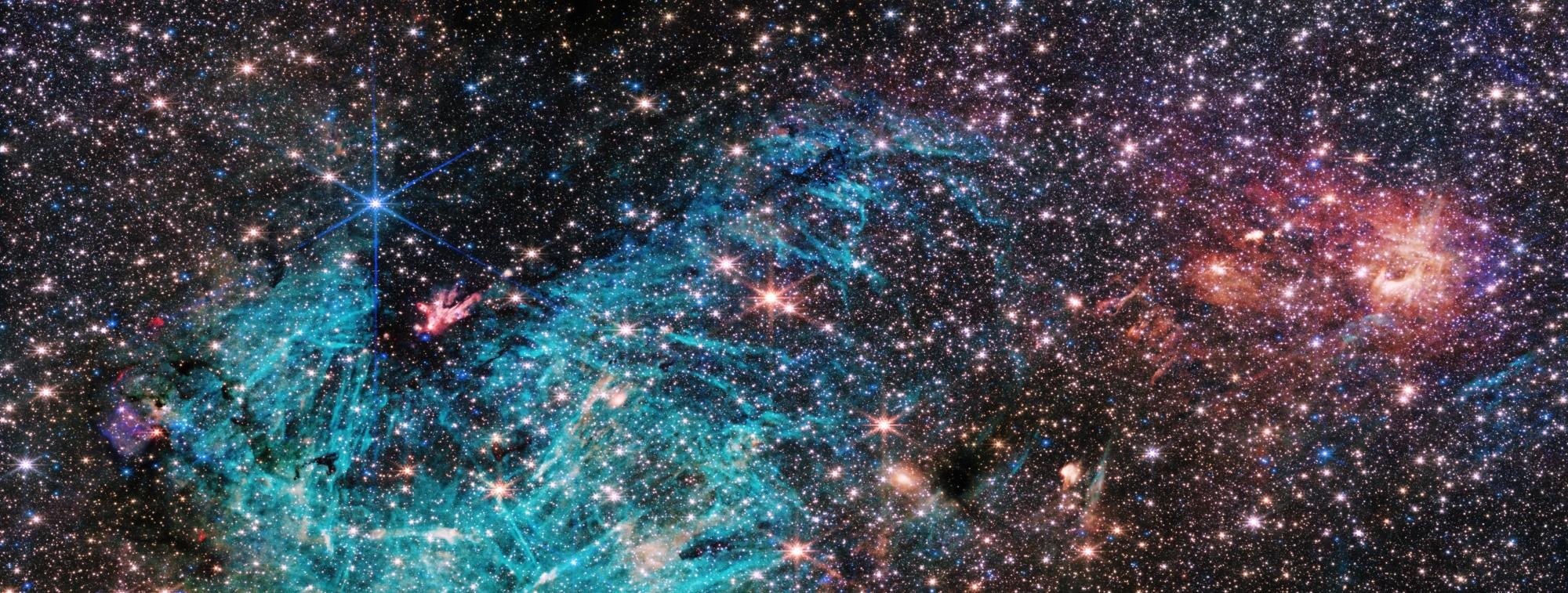The most recent image obtained by NASA’s James Webb Space Telescope provides remarkable clarity of a region of the galaxy’s dense center, including previously unseen characteristics that astronomers have not yet been able to explain. Sagittarius C (Sgr C), the star-forming area, is located around 300 light-years away from Sagittarius A*, the central supermassive black hole of the Milky Way.

The NIRCam (Near-Infrared Camera) instrument on NASA’s James Webb Space Telescope’s reveals a portion of the Milky Way’s dense core in a new light. An estimated 500,000 stars shine in this image of the Sagittarius C (Sgr C) region, along with some as-yet unidentified features. A large region of ionized hydrogen, shown in cyan, contains intriguing needle-like structures that lack any uniform orientation. Image Credit: NASA, ESA, CSA, STScI, and S. Crowe (University of Virginia)
There’s never been any infrared data on this region with the level of resolution and sensitivity we get with Webb, so we are seeing lots of features here for the first time. Webb reveals an incredible amount of detail, allowing us to study star formation in this sort of environment in a way that wasn’t possible previously.
Samuel Crowe, Principal Investigator and Undergraduate Student, University of Virginia
Professor Jonathan Tan, one of Crowe’s advisors at the University of Virginia, added, “The galactic center is the most extreme environment in our Milky Way galaxy, where current theories of star formation can be put to their most rigorous test.”
Protostars
A cluster of protostars, or stars that are still developing and acquiring mass can be seen among the image’s estimated 500,000 stars. These stars produce outflows that burn like a blaze in the middle of an infrared-dark cloud. A previously undiscovered enormous protostar with a mass over 30 times that of the Sun is located in the center of this nascent cluster.
Webb appears less crowded than it is because the cloud from which the protostars are emerging is so dense that Webb cannot receive light from the stars behind it. In reality, Webb is one of the most densely packed parts of the image. Tiny infrared dark clouds appear as holes in the starfield, scattered throughout the image. Future stars are forming there.
The image displays cyan coloration due to the large-scale emission from ionized hydrogen encircling the lower edge of the dark cloud, which was also captured by Webb's NIRCam (Near-Infrared Camera) sensor.
According to Crowe, young massive stars often generate energetic photons that cause this, but the large area that Webb has revealed is surprising and deserves more research. The needle-like formations in the ionized hydrogen, which appear to be orientated chaotically in multiple directions, are another aspect of the region that Crowe wants to investigate further.
The galactic center is a crowded, tumultuous place. There are turbulent, magnetized gas clouds that are forming stars, which then impact the surrounding gas with their outflowing winds, jets, and radiation. Webb has provided us with a ton of data on this extreme environment, and we are just starting to dig into it.
Rubén Fedriani, Co-Investigator, Instituto Astrofísica de Andalucía
The galactic center is located about 25,000 light-years from Earth, which makes it close enough to study individual stars with the Webb telescope. This has allowed astronomers to obtain previously unavailable data on the formation of stars and how they can be influenced by the cosmic environment, particularly when compared to other galactic regions. Is there a greater formation of massive stars in the heart of the Milky Way compared to the outside regions of its spiral arms?
Crowe added, “The image from Webb is stunning, and the science we will get from it is even better. Massive stars are factories that produce heavy elements in their nuclear cores, so understanding them better is like learning the origin story of much of the universe.”